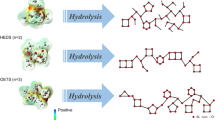Abstract
Synthesis of dimethylmethylphenylsiloxane rubbers with terminal hydroxyl groups by copolymerization of cyclosiloxanes can be accompanied by formation of low-molecular weight compounds, impurities, which are difficult to remove (because of target product affinity) and can lead to rubber opalescence. Identification of the impurities (the content of each impurity ≥10–4 wt % in 1 μL of the sample) can be carried out using a sensitive gas chromatography–mass spectrometry method. The method allows separation of the analyzed mixture into individual components on a capillary column. These components enter a mass analyzer and undergo electron ionization, which leads to their dissociation into pairs “cation–neutral fragment.” Only positively charged ions are observed in the mass spectra, which make it possible to predict the structure of the analyzed siloxane impurities. Rearrangement of linear and cyclic molecules occurring upon mass spectrometric fragmentation results in their transformation into cyclic and bicyclic cations. The structure of the cations formed under ionization conditions depends on the number of silanol bonds and their location in the molecule. To prove the presence of compounds with hydroxyl groups in the composition of impurities and to demonstrate the effect of electron ionization on the fragmentation of compounds with silanol bonds, a sample of oligomethylsiloxane with terminal trimethylsiloxy groups was synthesized in a similar way using the copolymerization method. Compounds with silanol bonds present in the composition of the impurities appear as chromatographic asymmetric peaks with ascending and descending gently sloping zones. Those compounds are rearranged either when passing through a chromatographic column owing to sorption-desorption and enter the detector in a modified form or drift through the column and undergo rearrangements already under conditions of electron ionization. The impurities contain linear and cyclic methylsiloxanes with silanol and phenyl bonds. The chromatography–mass spectrometry method provides a reliable control of the composition and content of undesirable impurities which cause rubber opalescence.






Similar content being viewed by others
REFERENCES
Silicon-Containing Polymers: The Science and Technology of Their Synthesis and Applications, Jones, R.G., Ando, W., and Chojnowski, J., Eds., New York: Springer-Verlag, 2000.
Ershov, O.L., Kochurkov, A.A., Semenkova, N.Yu., et al., RF Patent 2694845, 2019.
Semenkova, N.Yu., Nanush’yan, S.R., Popova, K.S., et al., Structuring of the organic-inorganic vinyl-containing oligomers, Nauchn. Obozr., 2012, no. 5, pp. 154–162.
Baney, R.H., Itoh, M., Sakaribaro, A., and Suzuki, N., Silsesquioxans, Chem. Rev., 1995, vol. 95, no. 5, pp. 1409–1430. https://doi.org/10.1021/cr00037a012
Buchachenko, A.L., Nanochemistry: a direct route to high technologies of the new century, Russ. Chem. Rev., 2003, vol. 72, no. 5, pp. 375–391.
Khananashvili, L.M., Khimiya i tekhnologiya elementoorganicheskikh monomerov i polimerov: uchebnik dlya vuzov (Chemistry and Technology of Organoelement Monomers and Polymers: Manual for Higher Education Institutions), Moscow: Khimiya, 1998.
Semenkova, N.Yu., Nanushyan, S.R., and Storozenko, P.A., Polyphenylsilsesquioxane-polydiorganosiloxane block copolymers, in Organosilicon Chemistry VI: From Molecules to Materials, Auner, N. and Weis, J., Eds., Chichester: Willey, 2005, pp. 792–795.
Orlov, V.Yu., Dissociation of methylsiloxanes by electron impact, Zh. Obshch. Khim., 1967, vol. 37, no. 9, pp. 2300–2307.
Orlov, V.Yu., Mass spectra of organometallic compounds of group IVb, Russ. Chem. Rev., 1973, vol. 42, no. 7, pp. 529–537.
Gorelov, S.M., Semenkova, N.Yu., and Ershov, O.L., RF Patent 2715888, 2020.
Zhigalin, G.Ya., Ershov, O.L., and Kochurkov, A.A., RF Patent 2513022, 2014.
Electronic library of mass-spectrum NIST/EPA/NIH (NIST 11). Mass Spectral Database, 2011.
Filippov, A.M., Ruscol, I.Yu., Shestakova, A.K., et al., Investigation of cyclic products of hydrolitic co-condensation of dimethyldichlorosilane and methyltrichlorosilane by chromatography-mass-spectrometry and 29Si-NMR, Proc. XIV Andrianov Conf. with Int. Participation “Organosilicon Compounds: Synthesis, Properties, Application,” June 3–6, 2018, Moscow, 2018, P-45.
Takhistov, V.V., Prakticheskaya mass-spektrometriya organicheskikh soedinenii: uchebnoe posobie (Practical Manual on Mass-Spectrometry of Organic Compounds), Leningrad: Leningr. Gos. Univ., 1977.
Bochkarev, V.N., Polivanov, A.N., Telegina, N.P., and Chernyshev, E.A., Mass spectrometric study of methylphenylcyclopenta- and methylphenylcyclohexasiloxanes, Zh. Obshch. Khim., 1974, vol. 44, no. 4, p. 965.
Polivanov, A.N., Bochkarev, V.N., Telegina, N.P., et al., Intermutual migration of substituents in methylphenylcyclotri- and methylphenylcyclotetrasiloxanes under electron impact, Zh. Obshch. Khim., 1974, vol. 44, no. 5, p. 1061.
Bochkarev, V.N., Polivanov, A.N., Sobolevskaya, L.V., et al., The formation of derivatives of 1,3-disyla-2-oxaindan and 9-silafluorene during the decay of methylphenyldisiloxanes and hexaphenyldisiloxane under electron impact, Zh. Obshch. Khim., 1974, vol. 44, no. 5, p. 1213.
Author information
Authors and Affiliations
Corresponding author
Additional information
Translated by A. Muravev
Rights and permissions
About this article
Cite this article
Filippov, A.M., Semenkova, N.Y., Gorelov, S.M. et al. Composition of Low-Molecular Weight Impurities in Dimethylmethylphenylsiloxane Rubbers with Terminal Hydroxyl Groups. Inorg Mater 57, 1447–1455 (2021). https://doi.org/10.1134/S0020168521140132
Received:
Revised:
Accepted:
Published:
Issue Date:
DOI: https://doi.org/10.1134/S0020168521140132



